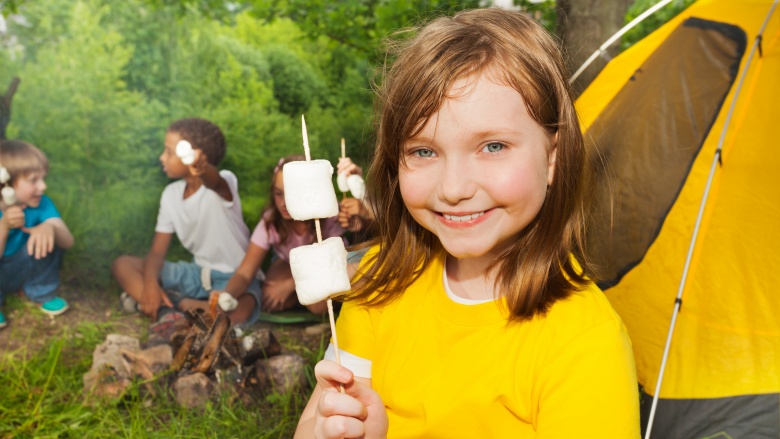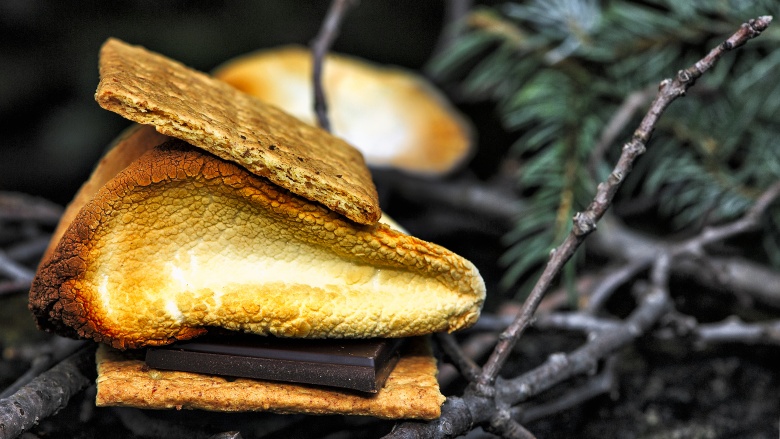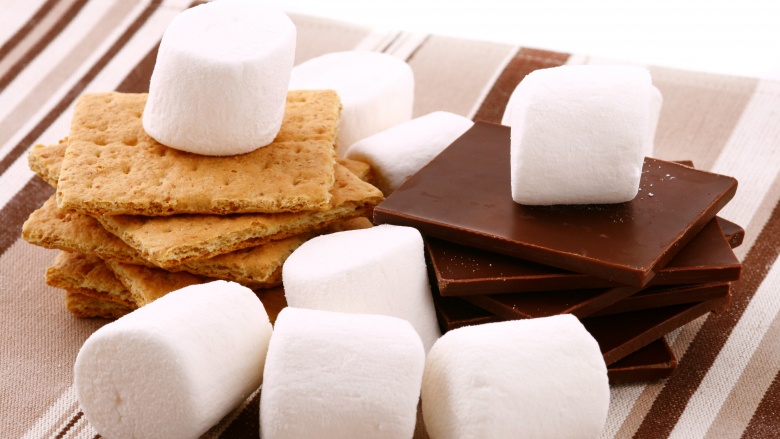Where Does The Term 'S'mores' Come From?
When autumn comes, so do hoodies, hot chocolate, and bonfires, and no bonfire would be complete without s'mores. Admittedly, s'mores are weird things, and whoever first thought of creating this chocolatey, marshmallowy goodness had to be a genius of some variety. So where did s'mores (and their bizarre name) come from? It's complicated.
How did s'mores get their name?
It seems likely that the invention of s'mores predates the name, but no one seems really sure of just where the name first came from. (Who doesn't love a good cooking mystery?) The earliest likely source seems to be a book published in 1927 for one of the most well-known makers of s'mores (and other cookies), the Girl Scouts. The book was called Tramping and Trailing With the Girl Scouts, and it was a sort of official guidebook to everything you needed to know to make your camping trips practical, educational, and fun at the same time. Included in the book were a series of recipes any good Girl Scout should know how to make over a campfire. One of those recipes is for "Some Mores," and the instructions say that the young cook should toast two marshmallows over the fire, then "put them inside a graham cracker and chocolate bar sandwich."
It seems logical that "s'mores" came about as a contraction of "Some Mores," but that doesn't really explain why they would be called something so odd. The guidebook also notes that, "Though it tastes like 'some more' one is really enough." It's an awkwardly worded note, but you get the idea. Moderation is a virtue, after all, and the "s'mores" name may have been a cautionary tale against overindulgence. (Not that anyone wants that warning.)
Loretta Scott Crew
You said you love a mystery, right? All good things come from somewhere, and a little more digging turns up Loretta Scott Crew's name. Her name is all over as the writer of that first s'mores recipe and the creation of the name in the Girl Scout guidebook. It even shows up on a blog for the Girl Scouts themselves. You can't get much more reliable than that, right?
But there's a claim that the entire person is a hoax. Part of the story shows up on another blog, this one written by a University of Georgia graduate named Meg Diamond. She claimed that a friend of hers had stumbled across the unknown author of the s'mores recipe and decided to give her a name: Loretta Scott Crew. This friend updated the Wikipedia page, and the myth took hold to be repeated again and again and again. True or not? No one has the slightest idea, and Crew's existence and authenticity has been hotly debated even on Wikipedia as a hoax, as no one has been able to find any reference of her before her appearance in 2009.
'S'mores' might not have been the original name
Do still more digging, and you'll find that the idea of s'mores showed up sometime in the 1920s, published in A Book of 150 Recipes Prepared with Campfire, the Original Food Marshmallows. This book simply called them "Campfire Graham Cracker Sandwiches," which is very descriptive but doesn't have quite the same ring to it. The recipe is exactly what you would expect it to be, so no surprises there. Interestingly, the book says it's specifically good for Girl Scouts and Boy Scouts to make around an outdoor campfire. It isn't clear exactly when in the decade the cookbook was published, so it may have come after the 1927 Girl Scouts guidebook.
The book is well worth scrolling through just for some historical kicks. You probably had no idea how many sandwiches, salads, and sauces could be made with marshmallows. Marshmallow pineapple ham? Marshmallow teas? Marshmallow salad dressings? They're all in there.
How did it all come together?
Girl Scouts might be the picture of innocence, but the individual ingredients of s'mores have some strange, strange stories attached to them. Marshmallows have been around for a few millennia, and they were once used as a cure for a sore throat. Fast-forward a bit, and you'll get to a weird fad of the late 1800s: the marshmallow roast. According to National Geographic, you would gather your friends and some marshmallows around a bonfire and voila! That's a marshmallow roast party. Eating another person's marshmallow off their stick was a very flirty move.
You're probably familiar with the idea of chocolate being an aphrodisiac, but graham crackers were intended to be exactly the opposite. They were named for creator Sylvester Graham, and Graham had a very specific thing in mind when he created the original graham cracker. Graham crackers were part of his Graham diet to reclaim American morality and suppress sexual desire. The diet replaced meat with intentionally bland foods, as well as daily exercise, comfortable clothing, and clean water. He collected his share of followers, and the so-called Grahamites even established some (male-only) boardinghouses where his diet was strictly observed and regular schedules kept everyone getting the right amount of exercise, sleep and baths. Oberlin College, even picked up his lifestyle for their entire faculty and student body, until one professor was fired for using black pepper.
So what does all this have to do with s'mores? Graham invented his crackers and bread because he was convinced that commercial bakeries were adding all kinds of bad things to their raw materials. He was actually right; food regulations were practically nonexistent. But that doesn't mean everyone wants a libido-killing cracker, either. That was in the early to mid-1800s, and it wasn't until a few decades after his death (when the riots he caused had faded from memory) that bakeries picked up his invention again and added sugar. Conveniently, that was only a decade or so after marshmallows around a campfire became the popular thing to do. The rest is, as they say, history.




